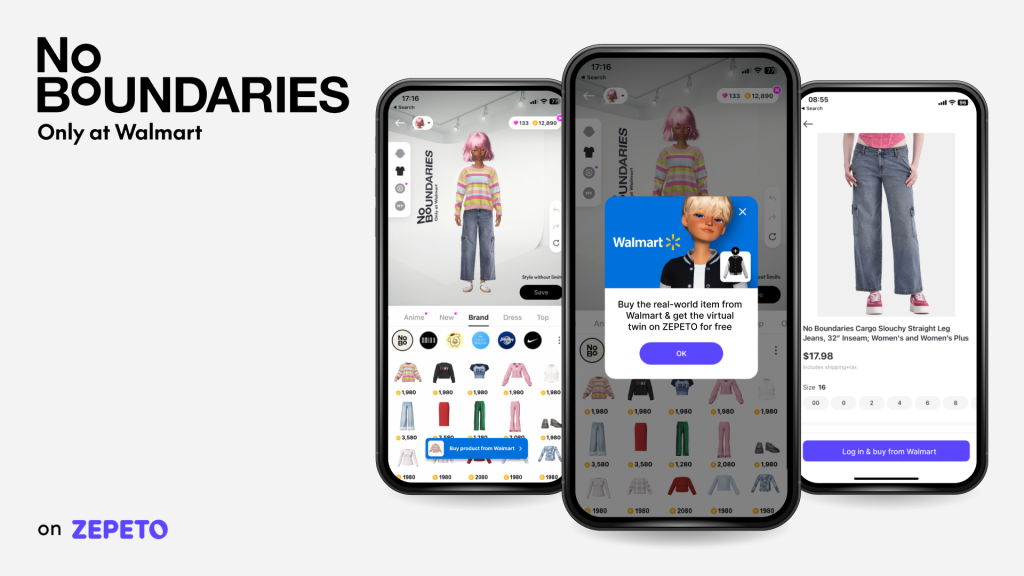Walmart deepens its metaverse presence with new e-commerce experience selling physical goods on Zepeto

As of today, Jan. 15, Walmart has doubled down on its push into the metaverse by launching Zepeto’s first-ever e-commerce experience for physical goods.
Zepeto is a digital avatar creation platform that allows its user base — which skews female and is roughly 70 percent Gen-Z, per Walmart and Zepeto — to create and share virtual experiences using digital representations of themselves. Now, Zepeto app users viewing virtual Walmart clothing items can use the app to log into their Walmart accounts and order physical versions of those items to be shipped directly to their doorsteps. Additionally, purchases of select physical garments in brick-and-mortar Walmart stores will also come with free downloads of their virtual equivalents on Zepeto.
The launch is Walmart’s third metaverse e-commerce experience, evidence that the retailer is playing the long game in its approach to virtual worlds. In April 2024, Walmart partnered with Roblox to open that platform’s first e-commerce experience for physical goods; in May 2024, Walmart opened its own virtual world platform featuring e-commerce opportunities, Walmart Realm.
Introducing e-commerce
Although Zepeto is smaller than the “big three” metaverse platforms of Roblox, Fortnite and Minecraft, it is a significant player in the virtual world game, boasting 20 million monthly active users, according to numbers shared by Zepeto and Walmart.
“The reason why Zepeto as a platform is so interesting compared with the other UGC [user-generated content] gaming platforms like Roblox and UEFN [Unreal Editor for Fortnite] is that image — including clothing, accessories, make up, et cetera — plays a bigger role in the players’ lives on-platform,” said Morgan Evans, the director of fashion and beauty for metaverse studio Karta.
Walmart has maintained an official partnership with Zepeto since last year, although company reps declined to share the specific terms of the agreement, such as how the companies will be sharing revenue from product sales. Beginning on Oct. 24, 2024, Zepeto users have been able to make their avatars try on virtual recreations of garments from Walmart’s No Boundaries brand, with a second item drop occurring last November. Today’s launch of e-commerce for physical goods also comes with an additional drop of 10 new clothing items.
Since the October launch, Zepeto users have tried on virtual Walmart items over 3.5 million times, according to figures shared by Walmart, 1.3 million purchases of virtual garments have been made and 1.87 million pieces of Zepeto content have been created using No Boundaries items. The company declined to say how many individual people had tried on or purchased the virtual Walmart items, but these numbers helped encourage Walmart to implement e-commerce into the experience.
“The upside of this is much stronger than any sort of risk, at this point, especially for a company as well-backed as Walmart,” said Jason Chung, director of esports and gaming at New York University. “As for Zepeto, they should have been doing this anyway — for a retailer, what’s the point of having any sort of avatar or interactive experience without an opportunity to directly buy off the platform?”
Gathering user data
The ability to gather concrete data about users’ preferences toward specific clothing items was one reason why Walmart decided to launch its latest virtual e-commerce experience on Zepeto rather than a rival metaverse platform, per Walmart head of brand marketing innovation Justin Breton. By working with Zepeto, Walmart is able to determine which clothing items are tried on most often, as well as which items are most often featured in user-generated Zepeto content. Through the October and November drops, for example, Walmart learned that virtual items displaying graphic designs or phrases performed better than traditional items such as unmarked sweaters or jeans.
“What’s great about Zepeto is that it’s actually giving us data and insights around that next generation of consumer that are actually applicable to platforms like Roblox and Minecraft and Fortnite, because of that notion that this next generation is using their virtual persona to make real-world purchases,” Breton said.

Zepeto’s Walmart e-commerce integration is currently live and will remain open indefinitely, with a Walmart rep telling Digiday that the company “will assess customer feedback and look to learn as much as we can before making any future decisions” regarding its Zepeto presence. The integration comes in the form of a virtual Walmart storefront accessible directly within the Zepeto app. Users viewing a virtual item inside Zepeto can click on a button to purchase a real-life version through a Walmart storefront embedded within the app, with a fulfillment process identical to that of any other online Walmart order.
“What that allows for is the customer or the user to feel safe and secure, because there is actually no new payment information being recorded,” Breton said. “It’s all being pulled directly from your Walmart account.”
Walmart’s decision to focus on virtual clothing items for its latest foray into the metaverse shows how the company has learned from its previous experiments in the space. In 2022, online observers clowned on the company for its Walmartland Roblox experience, which some users believed was devoid of meaningful content. And last year’s Roblox e-commerce launch, though innovative, focused on items such as water bottles and bags rather than virtual clothing. In contrast, Walmart’s Zepeto experience takes advantage of the virtual identity experimentation that drives users to the platform in the first place, giving users ample opportunities to alter their virtual appearance using No Boundaries items.
“On Zepeto, particularly when it comes to clothing and fashion, there’s a much higher propensity to spend on digital goods,” said Barney Lynch, an account director for data company GEEIQ, which has worked with Walmart and Zepeto to provide insights on both today’s launch and the companies’ past metaverse activations. “And the hope of the thing, that we’re really excited to learn, is whether that is also the case for physical goods.”
More in Marketing

Here are the winners and losers of TikTok’s U.S. shutdown drama
Congress’ ultimatum for ByteDance to sell TikTok or face a U.S. ban has come and gone without resolution. Still, this moment of limbo offers a chance to take stock.

Here’s a guide for what marketers can do now with the back-and-forth of TikTok
Some might be forgiven for downplaying contingency plans while others scrambled — though tempting fate has rarely been wise.

CMOs prepare for a Trump presidency in 2025 — which will be a different kind of CMO from his first term
This time around, it seems that CMOs will focus on getting back to the basics of marketing.








